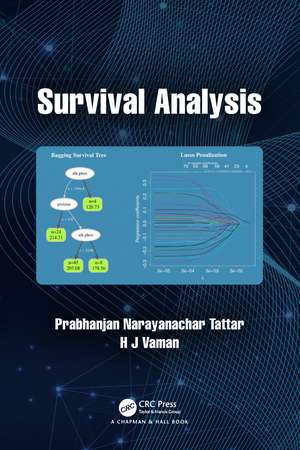Survival Analysis
Autor Prabhanjan Narayanachar Tattar, H J Vamanen Limba Engleză Hardback – 26 aug 2022
Survival Analysis offers an integrated blend of statistical methods and machine learning useful in analysis of survival data. The purpose of the offering is to give an exposure to the machine learning trends for lifetime data analysis.
Features:
- Classical survival analysis techniques for estimating statistical functional and hypotheses testing
- Regression methods covering the popular Cox relative risk regression model, Aalen’s additive hazards model, etc.
- Information criteria to facilitate model selection including Akaike, Bayes, and Focused
- Penalized methods
- Survival trees and ensemble techniques of bagging, boosting, and random survival forests
- A brief exposure of neural networks for survival data
- R program illustration throughout the book
Preț: 782.44 lei
Preț vechi: 954.19 lei
-18% Nou
Puncte Express: 1174
Preț estimativ în valută:
149.74€ • 162.59$ • 125.78£
149.74€ • 162.59$ • 125.78£
Carte tipărită la comandă
Livrare economică 22 aprilie-06 mai
Preluare comenzi: 021 569.72.76
Specificații
ISBN-13: 9780367030377
ISBN-10: 0367030373
Pagini: 296
Ilustrații: 6 Tables, black and white; 51 Line drawings, black and white; 2 Halftones, black and white; 53 Illustrations, black and white
Dimensiuni: 156 x 234 x 18 mm
Greutate: 0.45 kg
Ediția:1
Editura: CRC Press
Colecția Chapman and Hall/CRC
ISBN-10: 0367030373
Pagini: 296
Ilustrații: 6 Tables, black and white; 51 Line drawings, black and white; 2 Halftones, black and white; 53 Illustrations, black and white
Dimensiuni: 156 x 234 x 18 mm
Greutate: 0.45 kg
Ediția:1
Editura: CRC Press
Colecția Chapman and Hall/CRC
Cuprins
I Classical Survival Analysis. 1. Lifetime Data and Concepts. 2 Core Concepts. 3. Inference - Estimation. 4. Inference - Statistical Tests. 5. Regression Models. 6. Further Topics in Regression Models. 7. Model Selection.
II Machine Learning Methods. Why Machine Learning? 8. Survival Trees. 9. Ensemble Survival Analysis. 10. Neural Network Survival Analysis. 11. Complementary Machine Learning Techniques. Bibliography. Index.
II Machine Learning Methods. Why Machine Learning? 8. Survival Trees. 9. Ensemble Survival Analysis. 10. Neural Network Survival Analysis. 11. Complementary Machine Learning Techniques. Bibliography. Index.
Notă biografică
Prabhanjan Narayanachar Tattar is working as a Lead Data Scientist at British American Tobacco company, Malaysia. The author has published several books in Statistics: A Course in Statistics with R (Wiley), Statistical Application Development with R and Python, and Hands-on Ensemble Learning with R. He is recipient of the IBS(IR)- GK Shukla Young Biometrician Award (2005) and the Dr. U.S. Nair Award for Young Statistician (2007). He held SRF of CSIR-UGC during PhD. In the year 2021, he has ventured into ction writing and published three novels under the penname of S.B. Akshobhya: The Panipuri Crimes, Finding - A Measure of Her, and Prema Naada Pandita.
H. J. Vaman is a retired professor of Statistics. He taught for over 40 years at Bangaore University and Central University of Rajasthan. He has also served as visiting faculty at Shivaji University, University of Calcutta, Indian Statistical Institute, Bangalore Centre, IIT-Mumbai, and Mangalore University. His main areas of research are sequential decision processes, survival analysis, statistical process control, and modelling in certain health related studies.
H. J. Vaman is a retired professor of Statistics. He taught for over 40 years at Bangaore University and Central University of Rajasthan. He has also served as visiting faculty at Shivaji University, University of Calcutta, Indian Statistical Institute, Bangalore Centre, IIT-Mumbai, and Mangalore University. His main areas of research are sequential decision processes, survival analysis, statistical process control, and modelling in certain health related studies.
Descriere
The purpose of this book is to provide an account of survival analysis. The authors intend to accomplish it from two fronts: (i) methods in survival analysis developed over the past two decades and extending the scope of existing body of methods, and (ii) augmenting the traditional methods with their counterpart in machine learning.
